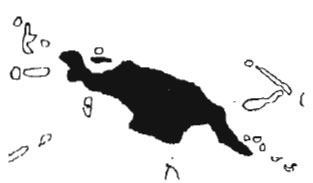Varanus Jobiensis
Ahl 1932Sepik monitor, Peach·throated monitor.
 |
Merlens noted that Sepik monitors were sympatric with mangrove monitors around Marienberg on the Sepik River. where available habitats include swamps, rainforests and grasslands. but how the ecologies of these animals differ is unknown. In captivity these lizards have been observed to be vigourous diggers (Horn 1977), and it could be surmised that the Sepik monitor is less aquatic in habit than the mangrove monitor. However they also like to sleep in mud. preferring it to water. Unfortunately observations of this species in the wild are entirely lacking. Whitaker et al (1982) record the species from the Eastern and Western Highlands and East and West Sepik Provinces in New Guinea. Mertens (1959, 1971) and Swanson (in Horn 1977) also record specimens from Lae and Bulolo in Morobe Province (Horn (1977) gives "Eastern Highlands District" for Bulolo) and Brown River in Central Province. No exact locations in Irian Jaya have been recorded except for the location of the type specimen of V.jobiensis; Yapan off the northern coast (Ahl 1932). The few data available strongly suggest that this monitor is widespread throughout the island except perhaps in the swamps and grasslands of the south. Horn (1977) notes that all specimens to date have been found in rainforests close to lakes at elevations of less than 1000m. A field study of these animals and their counterparts would be highly rewarding.
In colouration the Sepik monitor shows a great deal of variation. "Peach-throated" monitors have throats that range from white through yellow to red but are always lighter than the body colour. Melanistic animals with reduced pattern are known, they may be found in coastal regions, but accurate location data is lacking in almost all V.jobiensis known . Some specimens are breathtakingly beautiful. Colour pictures of this lizard can be found in Hom (1977) and Sprackland (1992).
In captivity this species tends to be shy and nervous, but usually groups of animals can be housed together safely. They will eat insects, small mammals. frogs and freshwater fish. Frogs are consumed avidly in captivity and may be an important food in the wild. Like other New Guinea monitor lizards they need to be maintained at a high temperature and with high humidity. The Sepik monitor has a reputation for doing poorly in captivity. Newly imported specimens are heavily loaded with a myriad of potentially lethal parasites, especially nasty amoebas. They need immediate and regular attention from a vet and should be dosed liberally with drugs until the prognosis is clear.
Attribution / Courtesy: Daniel Bennett. 1995. A Little Book of Monitor Lizards. Viper Press U.K.




